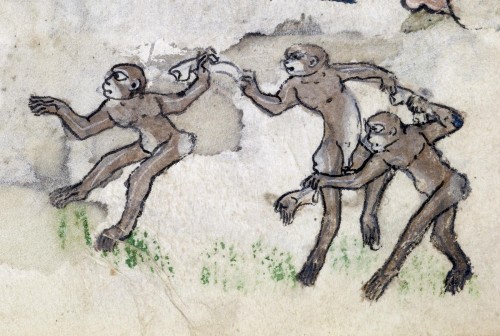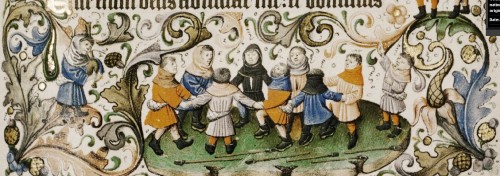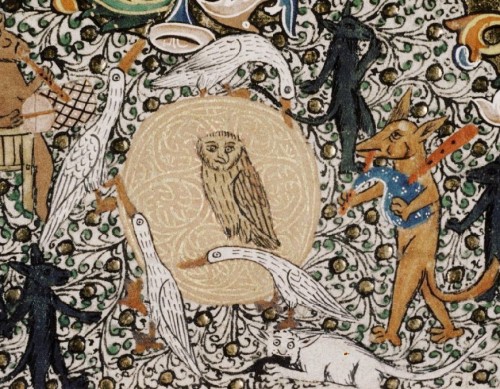A reader (who asked to remain anonymous) ((For obvious reasons. Why risk your name becoming associated with the #1 internet destination for medieval porn?)) poses the following question:
Have you seen this image of apes playing Ring Around the Rosie to ward off the plague at the Walters Museum’s site? I thought that explanation for that song had been debunked.
As it turns out, I hadn’t seen the image, so thank you, anonymous reader, for bringing this to us all:

Are these monkeys ((Yes, yes, I know they’re apes. Monkeys is a cooler word than apes.)) trying to ward off the plague? Not at all. Don’t blame the museum exhibiteers, though. It’s a very old mistake with an august history.
Snopes, home of the Internet’s foremost experts in debunkery, tackled this question back in 2007, and there’s not much I can add to their explanation. Indeed, it is so compelling that it managed to almost get the people who maintain the Wikipedia entry on the song to abandon their usual fetishization of impartiality that demands useless weasel sentences like this one in the entry’s head: “Urban legend says the song originally described the plague, but folklorists reject this idea.” ((Extend this sort of thinking to its logical end, and someone ought to go add to the top of the Moon’s page “Popular children’s lore says that the satellite is composed of green cheese, but geologists reject this idea.”, shouldn’t they?))
The version of the rhyme the kids knew when I was a kid was:
Ring around the rosies.
Pocket full of posies.
Upstairs, downstairs–
We all fall DOWN!
But you probably know a slightly different version, because that’s how things kids repeat at the playground work. ((If you’ve never compared notes on childhood rhymes and assorted games with friends, you’re in for a treat. You may even learn that some weirdos call “Duck Duck Goose” by the name “Duck Duck Gray Duck.” No, really!))
For those who want to see the Plague in a children’s game, the evidence is that 1) the ring of roses refers to the round red rash that is the first sign you’ve got the plague, 2) people put flowers in their pockets for protection against plague, 3) people’s skin gets ashy when they get the plague, OR their bodies are burnt to ashes when they die, OR the word is a corruption of “Achoo”, the sneezing sound plague victims make right before they die, ((No idea how my cohort’s “upstairs downstairs” fits into this.)) and 4) we all fall down because we’re dead of plague.
A quick summary of Snopes’ summary of the folklorist’s position should prove pretty darn convincing: the supposedly Plague-inspired “Ring-a-Round the Rosie” doesn’t appear anywhere in print until Kate Greenaway’s ((While a pretty awesome illustrator, she doesn’t seem to have ever been trained as a folk rhyme researcher or ethnographer or anything like that.)) Mother Goose or The Old Nursery Rhymes, published in 1881, over five hundred years after the Plague first hit England and two-hundred years after the last big plague outbreak there; the association with the Plague didn’t crop up until detective thriller author and amateur history buff James Leasor’s 1961 The Plague and the Fire, ((The book associated the rhyme with the Restoration outbreak of the plague that preceded the Great Fire of London in 1666.)) about a hundred years later still; there are dozens of versions of the Ring-a-round the Rosie rhyme that cropped up in the years immediately after 1881, but the earliest versions never seem to include the details that Leasor and others say correspond to the Plague; and, most importantly, most of the details about Plague don’t correspond to how the plague actually worked.
A red ring isn’t the first sign of plague. Other than fever, pains, and other general flu-like symptoms, it’s a red swelling of the lymph nodes that soon turns black. ((Do you often describe your bruises and blisters as rings?)) Flowers in your pockets wouldn’t ward off the Plague, certainly not a pocket of posies. ((Though a nosegay, a bouquet of fresh-smelling flowers (often made of posies) would be useful if you had to walk by a rotting body or wanted to ward off the evil air.)) As any good English plague survivor ((The idea that the plague was caused by Jews, a conjunction of planets, or “bad air” was really more a continental phenomenon.)) could tell you, the plague was caused by sin and best warded off by extreme piety and making sure your humours were in balance. ((And if you did get sick, best to get someone to bleed, sweat, or purge you, depending on which of your humours were out of balance, and if that failed, you could always use a pigeon feather to prick the swelling and drain its venom by applying pigeon dung.)) The skin of plague victims doesn’t get ashy–at least no more ashy than the typical sick person who’s been bled and covered in pigeon crap–though their fingers and toes might start rotting off and turn black. If you prefer “achoo” in the song to “ashes”, you get no better, as sneezing isn’t the final fatal symptom before you die of the plague, or a symptom at all, for that matter. I suppose people do fall down when they die, if they happen to be standing, so point there, urban legendists, but the rest of the evidence is pretty thin.
So what are the monkeys doing? Probably just dancing in a ring while not singing about rosies. Medievals, you see, loved dancing in rings–like square dancing, but probably cooler looking. ((And with fewer rhinestones.)) Like so: ((OK, I admit that it’s less cool and more “midgets in bathrobey”. But even that’s cooler than square dancing.))

In fact, medievals danced in rings so often that ring-dances show up in the most bizarre places. A common romance motif is for the hero to come across a group of dancers who are magically stuck together in a ring; anyone who joins the dance likewise gets stuck. (Until our intrepid hero–who’s probably Lancelot in disguise–breaks the magic.) And then there’s the marginal image I featured a few years back under the title “If You Give a Cat a Necklace“, which (my imaginative interpretation notwithstanding) actually depicts geese and foxes dancing together in a ring around an owl (while a feral cat feasts on a mouse nearby):

Sorry to be a killjoy, but what we have here in the Walters museum is just a plain old everyday humdrum case of ring-dancing monkeys. But speaking of both killjoys and old marginalia posts, another helpful reader wrote recently:
You know you messed up the counting when you numbered your marginalia posts? Two sets of seventies. And two different 82’s. You should be on 105 now, not 94.
(Through teeth gritted with ordinally-derived shame) I must thank the eagle-eyed, attentive Aspergerian reader. Yes indeedy, I did botch the reordering. That means today’s post marks 107 entries in this occasionally on-time weekly series.
Thus, retroactively, the 100th anniversary post turns out to have been this year’s New Years post. I didn’t intend it that way, but it works out nicely, as that post features images from many of the manuscripts I habitually feature. So it’s almost a best of.
See you next Monday for #108. ((Providing I don’t discover I’ve still further misordered the posts, which will likely happen, I’ll admit right now. This time, though, I’ll just edit the numbers silently and pretend it was this way all along, causing a certain dutiful reader to question his or her sanity… if all goes according to plan.))